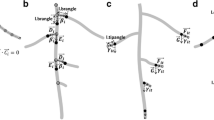Abstract
Aims
Determine if the root system of Lolium perenne L. (L perenne) is a continuous distribution of diameters, or a collection of discrete diameters classes.
Methods
Plants from tillers of five clones were grown in a local soil amended with lime. Roots were excavated after they were grown in soil for 54 days, washed and imaged with both a commercial scanner (94 px mm−1) and a high resolution, locally built, imager (204 px mm−1). Images were converted to diameter class length data with WinRhizo.
Results
Scanned images did not have enough resolution to accurately measure fine roots diameters (<0.09 mm diam.). Therefore the high resolution images were used. The diameter class length distributions (DCLD) of these images demonstrated diameter class clusters (meso diameter classes) which could be modeled with a non-linear Gaussian (normal) curve model. Recreating the whole root system from a compilation of the DCLD, regenerated from the three parameters of each of the Gaussian curves for the root system, produced a distribution visually identical to the original whole root system curve.
Conclusions
L perenne root systems are a collection of meso diameter classes easily described by non-linear Gaussian models. The data set of the parameters from these models is much smaller than a WinRhizo data set, and can reconstruct the original whole system DCLD.




Similar content being viewed by others
Notes
Mention of trade names or commercial products in this publication is solely for the purpose of providing specific information and does not imply recommendation or endorsement by the U.S. Department of Agriculture.
USDA is an equal opportunity provider and employer
References
Bonos SA, Rush D, Hignight K, Meyer WA (2004) Selection for deep root production in tall fescue and perennial ryegrass. Crop Sci 44:1770–1775
Crush JR, Easton HS, Waller JE, Hume DE, Faville MJ (2007) Genotypic variation in patterns of root distribution, nitrate interception and response to moisture stress of a perennial ryegrass (Lolium perenne L.) mapping population. Grass Forage Sci 62:265–273
Crush JR, Nichols SN, Easton HS, Ouyang L, Hume DE (2009) Comparisons between wild populations and bred perennial ryegrasses for root growth and root/shoot partitioning New Zealand. J Agric Res 52:161–169
Fitter AH (1987) An architectural approach to the comparative ecology of plant root systems. New Phytol 106:61–77
Glover JD, Reganold JP, Bell LW et al (2010) Increased food and ecosystem security via perennial grains. Science 328:1638–1639
Lynch JP (2007) Roots of the second green revolution. Aust J Bot 55:493–512
McCully M (1987) Selected aspects of the structure and development of field-grown roots with special reference to maize. In: Gregory P, Lake J, Rose D (eds) Root development and function. Cambridge University Press, Cambridge, pp 53–70
Smith ME, Zobel RW (1991) Plant genetic interactions in alternative cropping systems: considerations for breeding methods. In: Sleper DA, Barker TC, Bramel-Cox PJ (eds) Plant breeding and sustainable agriculure: considerations for objectives and methods. Crop Science Society of America Special Publication no. 18, pp 57–81
Tukey J (1962) The future of data analysis. Ann Math Stat 33:812
Walk TC, Jaramillo R, Lynch JP (2006) Architectural tradeoffs between adventitious and basal roots for phosphorus acquisition. Plant Soil 279:347–366. doi:10.1007/s11104-005-0389-6
Zobel RW (1975) The genetics of root development. In: Torrey JG, Clarkson DF (eds) The development and function of roots. Academic, London, pp 261–275
Zobel RW (2003) Sensitivity analysis of computer-based diameter measurement from digital images. Crop Sci 43:583–591
Zobel RW (2008) Hardware and software efficacy in assessment of fine root diameter distributions. Comput Electron Agric 60:178–189
Zobel RW (2011) A developmental genetic basis for defining root classes. Crop Sci 51:1410–1413. doi:10.2135/cropsci2010.11.0652
Zobel RW (2012) Modeling Lolium perenne L. roots in the presence of empirical black holes. In Lal, Timmons (eds), Modeling plant roots. Crop Science Books, In Press
Zobel RW, Waisel Y (2010) A plant root system architectural taxonomy: a framework for root nomenclature. Plant Biosyst 144:507–512
Zobel RW, Alloush GA, Belesky DP (2006) Differential root morphology response to no vs high phosphorus, in three forage chicory cultivars. Environ Exp Bot 57:201–208
Zobel RW, Kinraide TB, Baligar VC (2007) Fine root diameters can change in response to changes in nutrient concentrations. Plant Soil 297:243–254
Zobel RW, Cassida KA, Kinraide TB, Gonzalez JM, Foster JG (2012) Morphological response of forage chicory (Chicorum intybus L.) fine roots to manipulated soil phosphorus levels. J. Plant Nutrition. In Press
Acknowledgements
My sincere thanks to Tom Kinraide for his insistence that I become familiar with nonlinear regression techniques.
Author information
Authors and Affiliations
Corresponding author
Additional information
Responsible Editor: Alain Pierret.
Rights and permissions
About this article
Cite this article
Zobel, R.W. Lolium perenne L. root systems are a collection of Gaussian curve shaped meso diameter class length distributions. Plant Soil 363, 113–121 (2013). https://doi.org/10.1007/s11104-012-1298-0
Received:
Accepted:
Published:
Issue Date:
DOI: https://doi.org/10.1007/s11104-012-1298-0




